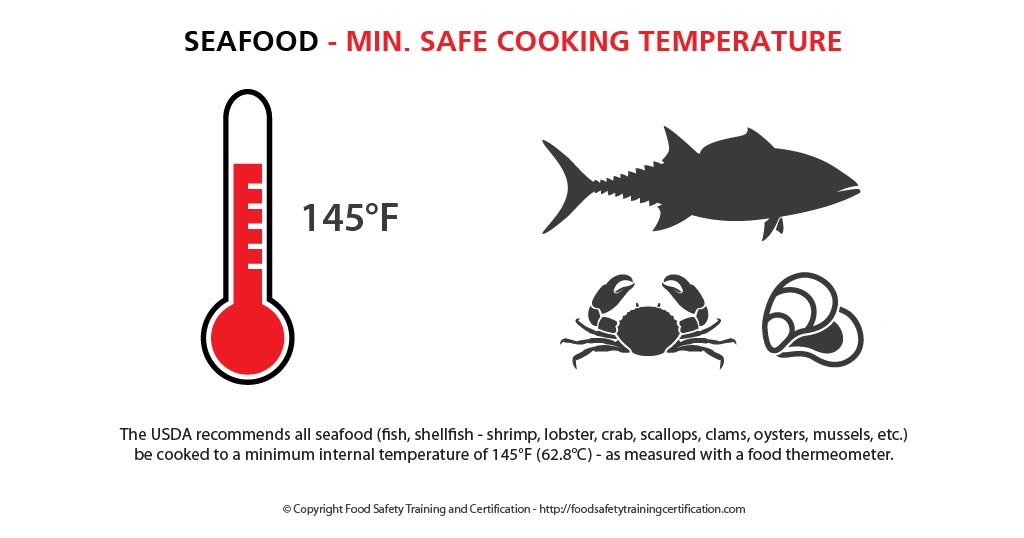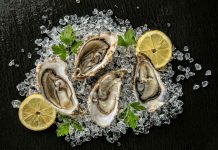Happy National Shrimp Day! Observed annually on May 10, Americans eat more shrimp than any other seafood.
Follow simple food safety guidelines to ensure your shrimp are properly selected, prepared, and cooked to be enjoyed safely. So, whether you barbecue it, boil it, broil it, bake it, sauté it, be sure to cook your shrimp to 145°F for at least 15 seconds so as safely enjoy and avoid foodborne illness.
Look for deals and share your favorite shrimp dish on social media using #NationalShrimpDay.



Facts about Shrimp Sources
Unless you live on the East, West, or Gulf Coast, in all likelihood, the shrimp you buy from your local supermarket or fish market is imported. Ninety percent of the shrimp we eat in the U.S. is imported.
- Learn about proper hygiene, cross contamination, cold and hot food safety, foodborne pathogens, and best practices to prevent foodborne illness.
- Food Manager Training & ANSI Certification - $99.00
- Food Handler Training - only $7.00!
- HACCP Training: 16hr/4hr/1hr
- Food Allergy Training - $15.00
- Enter Promo "train10off" at Checkout
Likewise, less than 2 percent of the world’s farmed shrimp is inspected by the USDA. So, it’s best to go with local wild-caught shrimp, rather than farmed shrimp that may have been treated with banned chemicals, antibiotics, pesticides, or other contaminants. If you must buy farm-raised shrimp, look for the “Best Aquaculture Practices Label” issued by the nonprofit Aquaculture Certification Council.
Things you need to know about buying “fresh” shrimp
Most shrimp sold as “fresh” at supermarket seafood counters have been flash frozen, then defrosted prior to sale. But, if you’re lucky enough to have a local fish market that is serviced by day boats, buy fresh. Otherwise, purchase shrimp that was frozen right after harvest. Shrimp freezes well—a lot better than fin fish.
Ask if you can get a closer look at the shrimp that is available at the seafood department of your grocer or at a fish market.
- Check that the head with antennae is still attached.
- Avoid any shrimp with missing or shrunken eyes. Instead the eyes should have a prominent appearance in the head and appear glossy or shiny.
- Look for shrimp that is still in its shell. If it is fresh, the shell should have a firm and glossy appearance. Black spots on the shell are an indication that the shrimp is no longer fresh was improperly rinsed and iced when it was originally harvested
- Avoid yellowing near the tail or swimmerets of the shrimp, as this is a sign of excess Sodium Bisulfate usage.
- Smell the shrimp for any offensive odors. Avoid any shrimp that has a rotten egg or ammonia smell, as this is an indication of decomposition. Be wary of chlorine smells as well as this is often used to mask offensive odors of shrimp that were not handled properly. Fresh shrimp should not have a strong odor and should smell of seawater or of seaweed.
- Educate yourself on the correct color for the type of shrimp that you are interested in so that you can detect abnormal color.
- Ask if you can touch one of the shrimp to make sure it feels moist and firm. Don’t purchase it if it is dry and tough, as this is a sign that it has been frozen for a long period of time. A chalky or mushy texture is also a sign that shrimp is not fresh and has been handled improperly. If it is slimy, this is an indication that the shrimp has been frozen and is not fresh. A slimy feel comes from too much Sodium Tripolyphosphate, which is used to reduce dehydration during freezing.
Store Shrimp and Seafood Properly
Place shrimp or other seafood on ice or in the refrigerator or freezer soon after buying it. If seafood will be used within 2 days after purchase, store it in the refrigerator. Otherwise, wrap it tightly in plastic, foil, or moisture-proof paper and store it in the freezer.
Separate Shrimp During Preparation to Avoid Cross-Contamination
When preparing fresh or thawed shrimp or other seafood, it’s important to prevent bacteria from the raw seafood from spreading to ready-to-eat food. Take these steps to avoid cross-contamination:
- When buying unpackaged cooked seafood, make sure it is physically separated from raw seafood.
- It should be in its own display case or separated from raw product by dividers.
- Wash your hands for at least 20 seconds with soap and warm water before and after handling any raw food.
- Wash cutting boards, dishes, utensils, and counter tops with soap and hot water between the preparation of raw foods, such as seafood, and the preparation of cooked or ready-to-eat foods.
- Kitchen sanitizers should be used on cutting boards and counter tops after use. Or use a solution of one tablespoon of unscented, liquid chlorine bleach to one gallon of water.
- If you use plastic or other non-porous cutting boards, run them through the dishwasher after use.
Cooking Shrimp and Seafood Properly
Most seafood should be cooked to an internal temperature of 145ºF. If you don’t have a food thermometer, there are other ways to determine whether seafood is done.
- Fish: The flesh should be opaque and separate easily with a fork
- Shrimp and Lobster: The flesh becomes pearly and opaque
- Scallops: The flesh turns opaque and firm
- Clams, Mussels, and Oysters: The shells open during cooking — throw out ones that don’t open



Serving Shrimp and Seafood
Follow these serving guidelines once your seafood is cooked and ready to be enjoyed.
- Never leave shrimp or other seafood or other perishable food out of the refrigerator for more than 2 hours or on ice for more than 1 hour when temperatures are above 90ºF. Bacteria that can cause illness grow quickly at warm temperatures (between 40ºF and 140ºF).
Keep hot seafood hot and cold seafood cold:
- Divide hot party dishes containing seafood into smaller serving platters. Keep platters refrigerated until time to reheat them for serving.
- Keep cold seafood on ice or serve it throughout the gathering from platters kept in the refrigerator.
Additional Resources
- Help With Cooking: Guide to Shrimp with Details on Choosing, Buying and Storing Fresh Prawns
- World’s Healthiest Foods: How to Select and Store
- Cooking Fish Monger: What to Look For When Buying Shell-On Shrimp
- Food Reference.com: Shrimp
- Eating Fish: What Pregnant Women and Parents Should Know
- FDA.gov: Fresh and Frozen Seafood: Selecting and Serving It Safely
- Food Safety for Moms-to-Be






